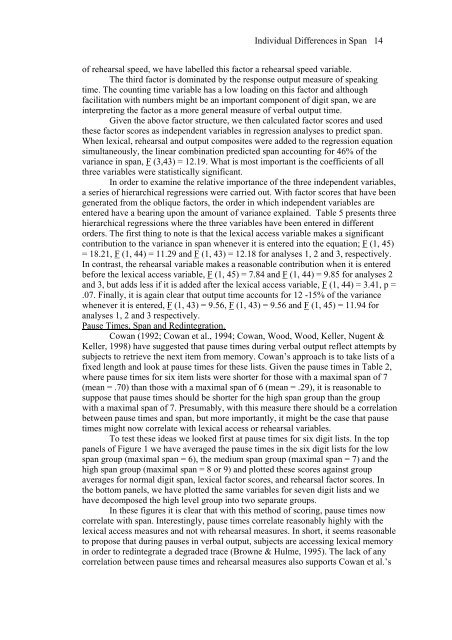Individual Differences in Span 1 Individual Differences in Memory ...
Individual Differences in Span 1 Individual Differences in Memory ...
Individual Differences in Span 1 Individual Differences in Memory ...
You also want an ePaper? Increase the reach of your titles
YUMPU automatically turns print PDFs into web optimized ePapers that Google loves.
<strong>Individual</strong> <strong>Differences</strong> <strong>in</strong> <strong>Span</strong> 14<br />
of rehearsal speed, we have labelled this factor a rehearsal speed variable.<br />
The third factor is dom<strong>in</strong>ated by the response output measure of speak<strong>in</strong>g<br />
time. The count<strong>in</strong>g time variable has a low load<strong>in</strong>g on this factor and although<br />
facilitation with numbers might be an important component of digit span, we are<br />
<strong>in</strong>terpret<strong>in</strong>g the factor as a more general measure of verbal output time.<br />
Given the above factor structure, we then calculated factor scores and used<br />
these factor scores as <strong>in</strong>dependent variables <strong>in</strong> regression analyses to predict span.<br />
When lexical, rehearsal and output composites were added to the regression equation<br />
simultaneously, the l<strong>in</strong>ear comb<strong>in</strong>ation predicted span account<strong>in</strong>g for 46% of the<br />
variance <strong>in</strong> span, F (3,43) = 12.19. What is most important is the coefficients of all<br />
three variables were statistically significant.<br />
In order to exam<strong>in</strong>e the relative importance of the three <strong>in</strong>dependent variables,<br />
a series of hierarchical regressions were carried out. With factor scores that have been<br />
generated from the oblique factors, the order <strong>in</strong> which <strong>in</strong>dependent variables are<br />
entered have a bear<strong>in</strong>g upon the amount of variance expla<strong>in</strong>ed. Table 5 presents three<br />
hierarchical regressions where the three variables have been entered <strong>in</strong> different<br />
orders. The first th<strong>in</strong>g to note is that the lexical access variable makes a significant<br />
contribution to the variance <strong>in</strong> span whenever it is entered <strong>in</strong>to the equation; F (1, 45)<br />
= 18.21, F (1, 44) = 11.29 and F (1, 43) = 12.18 for analyses 1, 2 and 3, respectively.<br />
In contrast, the rehearsal variable makes a reasonable contribution when it is entered<br />
before the lexical access variable, F (1, 45) = 7.84 and F (1, 44) = 9.85 for analyses 2<br />
and 3, but adds less if it is added after the lexical access variable, F (1, 44) = 3.41, p =<br />
.07. F<strong>in</strong>ally, it is aga<strong>in</strong> clear that output time accounts for 12 -15% of the variance<br />
whenever it is entered, F (1, 43) = 9.56, F (1, 43) = 9.56 and F (1, 45) = 11.94 for<br />
analyses 1, 2 and 3 respectively.<br />
Pause Times, <strong>Span</strong> and Red<strong>in</strong>tegration.<br />
Cowan (1992; Cowan et al., 1994; Cowan, Wood, Wood, Keller, Nugent &<br />
Keller, 1998) have suggested that pause times dur<strong>in</strong>g verbal output reflect attempts by<br />
subjects to retrieve the next item from memory. Cowan’s approach is to take lists of a<br />
fixed length and look at pause times for these lists. Given the pause times <strong>in</strong> Table 2,<br />
where pause times for six item lists were shorter for those with a maximal span of 7<br />
(mean = .70) than those with a maximal span of 6 (mean = .29), it is reasonable to<br />
suppose that pause times should be shorter for the high span group than the group<br />
with a maximal span of 7. Presumably, with this measure there should be a correlation<br />
between pause times and span, but more importantly, it might be the case that pause<br />
times might now correlate with lexical access or rehearsal variables.<br />
To test these ideas we looked first at pause times for six digit lists. In the top<br />
panels of Figure 1 we have averaged the pause times <strong>in</strong> the six digit lists for the low<br />
span group (maximal span = 6), the medium span group (maximal span = 7) and the<br />
high span group (maximal span = 8 or 9) and plotted these scores aga<strong>in</strong>st group<br />
averages for normal digit span, lexical factor scores, and rehearsal factor scores. In<br />
the bottom panels, we have plotted the same variables for seven digit lists and we<br />
have decomposed the high level group <strong>in</strong>to two separate groups.<br />
In these figures it is clear that with this method of scor<strong>in</strong>g, pause times now<br />
correlate with span. Interest<strong>in</strong>gly, pause times correlate reasonably highly with the<br />
lexical access measures and not with rehearsal measures. In short, it seems reasonable<br />
to propose that dur<strong>in</strong>g pauses <strong>in</strong> verbal output, subjects are access<strong>in</strong>g lexical memory<br />
<strong>in</strong> order to red<strong>in</strong>tegrate a degraded trace (Browne & Hulme, 1995). The lack of any<br />
correlation between pause times and rehearsal measures also supports Cowan et al.’s
















